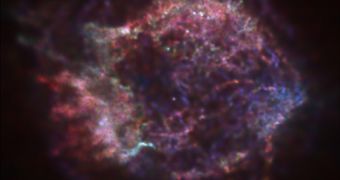Some ten years ago, the remnants of the supernova Cassiopeia A were first discovered, and astronomers were able to observe for the first time a very clear structure, with little details also visible. Now, more than a decade later, scientists using both space- and ground-based telescopes managed to get a glimpse of how the remnants evolve in real time, and not just take a picture of them once in a while. By using the Chandra X-ray Observatory, they managed to identify layers of components that led to the explosion of the supernova, and to separate them into two groups.
But maybe the biggest accomplishment of the current endeavor was the fact that the astronomers managed to create the first “fly-through” image of the remnants, using 3D technology.
"With Chandra, we have watched Cas A over a relatively small amount of its life, but so far the show has been amazing. And, we can use this to learn more about the aftermath of the star's explosion," says Daniel Patnaude, an expert at the Smithsonian Astrophysical Observatory in Cambridge, Massachusetts.
"We have always wanted to know how the pieces we see in two dimensions fit together with each other in real life. Now we can see for ourselves with this 'hologram' of supernova debris," adds Tracey DeLaney from MIT.
“Right now, we are focusing on improving three-dimensional visualization in both astronomy and medicine. This project with Cas A is exactly what we have hoped would come out of it," says Alyssa Goodman, the leader of the Astronomical Medicine project at Harvard.
The new data will have to be incorporated into new supernova explosion models, as the movie provides valuable insight into how the gases coming out of exploding supernovas expand and seed cosmic gas clouds, out of which other stars are born. Cassiopeia A is the best example for studying such a thing, as it is believed to have exploded just 330 years ago, making it the youngest such remnant close to us.
This movie of X-ray data from Chandra was made by combining observations taken in January 2000, February 2002, February 2004 and December 2007.
Credits: NASA/CXC/SAO/D. Patnaude et al.

 14 DAY TRIAL //
14 DAY TRIAL //